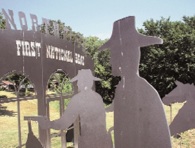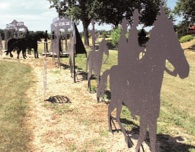 It’s not your typical theme park, art exhibit or history lesson. Amid southern Minnesota woods and farmland, Arnie Lillo has blended sheet metal “yard art” with the history of perhaps the West’s most infamous bank robbery.
It’s not your typical theme park, art exhibit or history lesson. Amid southern Minnesota woods and farmland, Arnie Lillo has blended sheet metal “yard art” with the history of perhaps the West’s most infamous bank robbery.
More than a century ago, this gently rolling landscape became Jesse James country. On September 7, 1876, Jesse and Frank James, three of the Younger brothers and at least three other outlaws robbed the First National Bank in Northfield, Minn.
The result was a bloodbath. Within seven minutes, acting cashier Joseph Lee Heywood had been murdered inside the bank, another townsman had been mortally wounded, two outlaws lay dead in the streets and what was left of the James-Younger Gang had ridden out, shot to pieces, with $26 and change. Minnesota’s largest manhunt would ensue, leading to the capture of Cole, Jim and Bob Younger and death of Charlie Pitts (real name Samuel Wells) at Hanska Slough on September 20. The two James brothers made it home to Missouri.
Prior to the Hanska Slough gunfight, people had spotted the fleeing outlaws on the road between Good Thunder and Mankato—and they’re still here, at least in Lillo’s sheet-metal versions. The artist’s unique Jesse James Theme Park, on his 13-acre “hobby farm” at Good Thunder, relates the story of the robbery, manhunt and capture of the Youngers. A metals fabricator, Lillo established a niche market a decade ago when he began his business, Timeless Images in Metal, re-creating everything from antique tractor parts and cupolas to weathervanes, lamps and yard art. Then he met historians Rex Macbeth and John J. Koblas and became hooked on the Jesse-in-Minnesota story.
“Just listening to Rex Macbeth (who died in 2006), I got to thinking somebody ought to do a theme park on the James-Younger Gang,” Lillo says. “Then I met Jack Koblas, and it just took off from there.”
In October 2004, Lillo set to work, cutting out of quarter-inch steel a figure of Axle Oscar Sorbel, the young farm boy who, suspicious of strangers who passed the family farm outside Madelia, helped lead a posse to Hanska Slough. By the following July, Lillo’s sheet-metal story was complete.
 The story begins with the long riders entering Northfield. Other scenes depict the bank robbery and flight from town, the gunfight at Hanska Slough and the return of the heroic posse, known as the Magnificent Seven, to Madelia with the three Younger brothers, all badly wounded, and the body of Pitts/Wells.
The story begins with the long riders entering Northfield. Other scenes depict the bank robbery and flight from town, the gunfight at Hanska Slough and the return of the heroic posse, known as the Magnificent Seven, to Madelia with the three Younger brothers, all badly wounded, and the body of Pitts/Wells.
“Arnie is a true craftsman,” Koblas says. “He does with his hands and heart what so many of us try to accomplish with our pens. His Jesse James Theme Park is a one-of-a-kind experience not to be missed by Old West outlaw aficionados and history buffs. And don’t forget your camera.”
The metal skills might have come naturally for Lillo, but history is another story.
“I didn’t have a clue about this,” Lillo says. “This is something that just happened. History was my poorest subject in school. I didn’t like it. Now I wish I had really buckled down and studied it. Now I get to do the research.”
A sheet-metal journeyman, Lillo had worked in welding, cutting, grinding and fabricating. He escaped to farm country after spending time in Mankato. “My neighbor didn’t like me welding in my garage,” he says.
He had no plans to enter the theme-park business.
Lillo’s depiction of the James-Younger Gang’s ill-fated foray into Minnesota may be complete, but his work is far from done. He’s still making weathervanes and shaping metal for other projects—like the 29-foot, 850-pound weathervane to replace the one a tornado ripped off the county courthouse in St. Peter—and he seems to be hooked on history. Behind his farm, he’s fabricating a life-size Indian village. Then there’s the portable jail cell he brings to parades, not to mention the miniatures he sells.
“I’ll get to the shop in the morning,” he says of his work schedule, “and work 10 hours a day. Sometimes 12. Sometimes till midnight. Sometimes I’ll work till 2 in the morning. I hate to quit when doing something interesting.”
Browse Arnie Lillo’s artwork online at www.arnielillo.com.
Click here to read more about artist Arnie Lillo.




